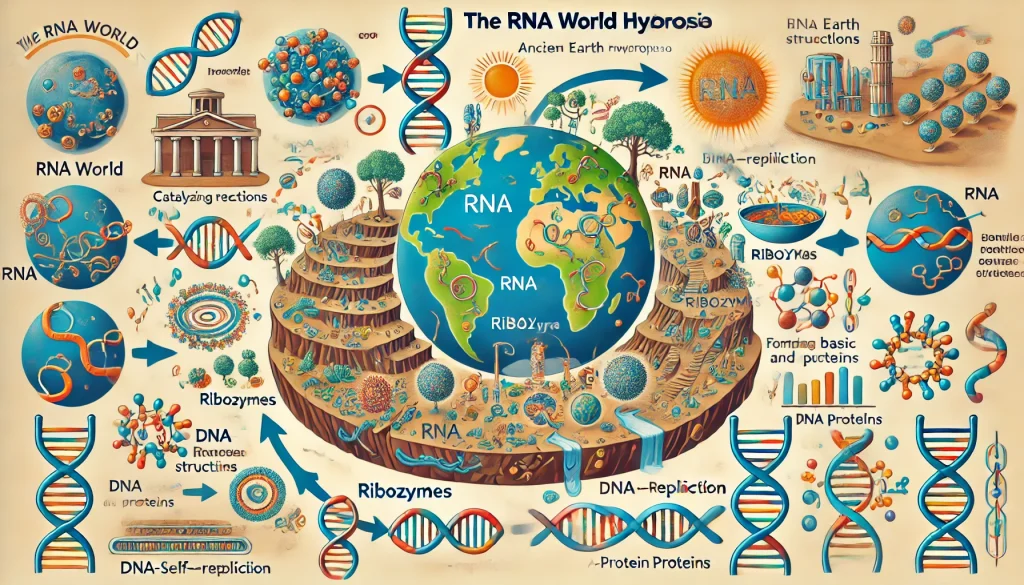The RNA world hypothesis suggests that RNA (ribonucleic acid) was a critical molecule in the early stages of life on Earth, potentially serving as the precursor to both DNA (deoxyribonucleic acid) and proteins. This hypothesis has profound implications for the molecular basis of inheritance and our understanding of how life’s genetic systems evolved. The RNA world hypothesis posits that RNA may have been the first molecule capable of both storing genetic information and catalyzing chemical reactions, playing dual roles in early life forms before DNA and proteins became dominant. Here’s a detailed explanation of this concept:

1. The Origins of the RNA World Hypothesis
The concept of an “RNA world” was proposed by scientists Carl Woese, Francis Crick, and Leslie Orgel in the 1960s and gained substantial support through the work of Thomas Cech and Sidney Altman in the 1980s. Cech and Altman independently discovered that RNA molecules could act as enzymes, a groundbreaking finding that revealed RNA’s potential role in catalyzing biochemical reactions, in addition to carrying genetic information.
Traditionally, it was believed that proteins served as enzymes and DNA as the hereditary material. However, the discovery of ribozymes (RNA molecules with enzymatic activity) supported the idea that RNA could fulfill both roles. This dual capability allowed scientists to speculate that early life might have relied solely on RNA before evolving to incorporate DNA and proteins, giving rise to the concept of an RNA world.
2. RNA’s Dual Role: Catalysis and Information Storage
In modern organisms, DNA serves as the genetic blueprint, proteins act as the functional molecules, and RNA functions as an intermediary. However, in an RNA world, RNA would have carried out all these roles. Its versatility stems from its unique structure and properties:
- Information Storage: Like DNA, RNA is composed of nucleotide bases (adenine, cytosine, guanine, and uracil instead of thymine) that can form a sequence representing genetic information. This sequence can be copied, allowing RNA to pass information from one generation to the next. This capability of storing and transmitting genetic data would have allowed early life forms to retain and inherit information.
- Catalytic Function: Ribozymes demonstrate that RNA can catalyze certain chemical reactions. For example, the ribosome, which synthesizes proteins in all modern cells, is a ribozyme, highlighting RNA’s catalytic potential. RNA’s ability to fold into complex three-dimensional shapes allows it to form active sites, similar to protein enzymes, where it can perform biochemical reactions. This dual functionality would have been invaluable in a pre-protein world, enabling RNA to drive essential reactions needed for life.
3. Evidence Supporting the RNA World Hypothesis
Several lines of evidence support the idea that RNA preceded DNA and proteins in the evolution of life:
The Role of Ribozymes
The discovery of ribozymes was a pivotal moment for the RNA world hypothesis. Ribozymes are RNA molecules that can catalyze specific biochemical reactions, such as the cleavage and ligation of other RNA molecules. This catalytic ability indicates that RNA alone could have managed the biochemical processes necessary for early life, such as replication, without the aid of proteins.
Ribosomes as Evidence of an RNA World
Ribosomes, the molecular machines responsible for protein synthesis in all living cells, are themselves ribozymes. Ribosomes are composed of both RNA and proteins, but it is the RNA component that performs the catalytic function in the formation of peptide bonds between amino acids. This suggests that RNA-based catalysis may be an ancient trait preserved from a time when life was dependent on RNA rather than proteins.
RNA Replication
RNA has the capacity to self-replicate, a key requirement for any hereditary molecule. Certain types of ribozymes have been shown to catalyze RNA replication under laboratory conditions, providing a potential mechanism for how early RNA-based life forms could have reproduced. While modern RNA requires enzymes to replicate, the discovery that some RNA molecules can catalyze their own assembly suggests that early life could have relied on this process.
The Primordial Soup and Prebiotic Chemistry
Research into prebiotic chemistry—the study of how biological molecules could have formed spontaneously on early Earth—has shown that RNA nucleotides (the building blocks of RNA) can be synthesized under conditions that might have existed in Earth’s early environment. Experiments such as the Miller-Urey experiment demonstrate that organic molecules, including amino acids, could form under simulated early Earth conditions. More recent experiments have successfully created RNA precursors, suggesting that the building blocks of RNA could have been present in the “primordial soup” of prebiotic Earth.
4. Transition from RNA to DNA and Proteins
If RNA was indeed the first molecule to perform both genetic and catalytic functions, the next question is: how did DNA and proteins come to dominate the molecular landscape of modern life?
Evolution of DNA from RNA
DNA is more chemically stable than RNA, primarily because it lacks the hydroxyl group on the ribose sugar that makes RNA more prone to hydrolysis. This stability is advantageous for long-term storage of genetic information. It is hypothesized that DNA evolved as a more stable repository of genetic information, with thymine (T) replacing uracil (U) for better error detection and correction. This allowed organisms to pass down genetic information more accurately over generations.
DNA may have initially been synthesized by modification of RNA nucleotides or through an intermediate form of RNA-DNA hybrid molecules. Once DNA was established as the primary storage molecule, RNA’s role shifted to that of a messenger and functional molecule in gene expression, bridging the gap between DNA and protein synthesis.
Evolution of Proteins from RNA Catalysts
While RNA can catalyze reactions, proteins are far more versatile and efficient due to their complex structures and the wide variety of amino acids they contain. It is thought that, over time, proteins began to take over catalytic roles from RNA because their structural diversity allowed for more complex and efficient reactions. The emergence of proteins likely drove the development of more complex cellular processes, enabling the evolution of life’s diversity.
5. The Role of RNA in Modern Cells
In modern cells, RNA still plays a crucial role, supporting the idea that life evolved from an RNA world. RNA molecules are essential for gene expression, serving as intermediaries between DNA and proteins. Some key roles include:
- Messenger RNA (mRNA): Carries genetic information from DNA to ribosomes for protein synthesis.
- Transfer RNA (tRNA): Transfers amino acids to the ribosome during translation, helping build proteins based on mRNA sequences.
- Ribosomal RNA (rRNA): Forms the core of ribosome structure and catalyzes protein synthesis.
- Small nuclear RNA (snRNA) and small nucleolar RNA (snoRNA): Involved in RNA processing and modification.
These various roles highlight RNA’s versatility and show that, although life has evolved beyond the RNA world, RNA remains central to cellular function.
6. Implications of the RNA World Hypothesis for the Origin of Life
The RNA world hypothesis has profound implications for understanding how life may have originated:
Self-Replication and Natural Selection
RNA’s ability to store information and catalyze reactions suggests that early RNA molecules capable of self-replication might have undergone natural selection. RNA molecules that replicated more efficiently or catalyzed essential reactions would have been favored, driving the evolution of increasingly complex forms.
Chemical Evolution and Abiogenesis
The idea of an RNA world bridges the gap between simple chemical reactions and biological life. RNA’s dual role as a catalyst and information carrier provides a plausible intermediate step in the transition from chemistry to biology. This supports the theory of abiogenesis, the process by which life arises naturally from non-living matter.
The Search for Extraterrestrial Life
If RNA can both store genetic information and catalyze essential reactions, it could also be the foundation for life on other planets. Understanding the RNA world increases our chances of identifying life elsewhere in the universe, as it suggests that RNA-based life forms might emerge under the right conditions, without necessarily evolving into DNA-protein systems.
7. Criticisms and Challenges of the RNA World Hypothesis
While the RNA world hypothesis is widely accepted, it faces several challenges:
- Formation of RNA Molecules: Although RNA nucleotides have been synthesized in laboratory settings, the spontaneous formation of complete RNA strands in prebiotic conditions remains challenging. Some scientists question whether long RNA molecules could have formed naturally on early Earth.
- RNA Stability: RNA is more prone to degradation than DNA, and environmental factors could have made it difficult for RNA to persist in early Earth conditions. Some researchers propose that other molecules, like peptides or short proteins, may have coexisted with RNA, stabilizing it.
- Alternatives to RNA: Some theories propose that simpler molecules may have preceded RNA, potentially acting as a precursor to the RNA world. Molecules like peptide nucleic acids (PNAs) and threose nucleic acids (TNAs) have been suggested as alternative hereditary materials.
8. Conclusion: The Legacy of the RNA World
The RNA world hypothesis offers a compelling explanation for the molecular basis of inheritance and the evolution of life’s genetic systems. It suggests that RNA was likely the first molecule capable of both carrying genetic information and catalyzing chemical reactions, providing a crucial stepping stone in the emergence of life.
Although DNA and proteins have largely taken over these roles, RNA remains a central player in modern biology, serving as a reminder of life’s ancient origins. By studying RNA and its catalytic properties, scientists gain insights into life’s early molecular systems and the possible origins of life on Earth and beyond. The RNA world hypothesis continues to be a foundation for exploring the molecular evolution of inheritance, catalysis, and the fundamental principles of biology.
10 Questions, each Answered “RNA World” Hypothesis and the Molecular basis of inheritance:
1. What is the RNA World Hypothesis?
- Answer: The RNA World Hypothesis proposes that early life forms relied solely on RNA for both genetic information storage and catalysis of chemical reactions. This hypothesis suggests that RNA could have been the original molecule of life due to its ability to both store genetic information (like DNA) and catalyze reactions (like proteins). The hypothesis gained support with the discovery of ribozymes, RNA molecules that act like enzymes, indicating RNA’s potential to play dual roles before DNA and proteins became specialized.
2. Why is RNA thought to have come before DNA in early life forms?
- Answer: RNA is believed to predate DNA because it can perform dual functions: it can store genetic information and catalyze reactions. DNA, while better for long-term information storage, does not catalyze reactions. RNA’s simpler structure and ability to replicate make it a plausible precursor to DNA. Over time, as life became more complex, DNA likely evolved to serve as a more stable genetic material, while proteins became the primary catalysts, with RNA taking on more specialized roles.
3. How do ribozymes support the RNA World Hypothesis?
- Answer: Ribozymes, RNA molecules with enzymatic activity, are essential evidence for the RNA World Hypothesis. Ribozymes show that RNA can catalyze reactions, similar to proteins. This catalytic property implies that RNA could have driven biochemical reactions in early life. The discovery of ribozymes in modern organisms (like the ribosome, where RNA catalyzes peptide bond formation) provides a glimpse of RNA’s ancient role in catalysis and supports the idea of an RNA-based early life system.
4. How does RNA’s structure allow it to perform both genetic and catalytic functions?
- Answer: RNA’s structure allows it to perform both functions due to its single-stranded nature, which can fold into complex 3D shapes, forming active sites that facilitate chemical reactions. Additionally, its sequence of bases (adenine, uracil, cytosine, and guanine) allows it to store genetic information. This combination of flexibility and base-pairing capabilities means RNA could store genetic information like DNA while also forming structures to catalyze reactions, unlike DNA, which is double-stranded and primarily a stable information storage molecule.
5. Why is the stability of RNA an issue in the RNA World Hypothesis?
- Answer: RNA is chemically less stable than DNA because it has a hydroxyl group on the ribose sugar, which makes it more prone to degradation. This instability is a challenge because it suggests that RNA might not have lasted long enough in harsh early Earth conditions to support life. However, some scientists propose that primitive cellular structures or other stabilizing molecules could have protected RNA, allowing it to persist and carry out necessary functions.
6. How might RNA have led to the development of DNA?
- Answer: RNA might have led to DNA by first evolving enzymes capable of synthesizing DNA nucleotides. DNA lacks the reactive hydroxyl group found in RNA, making it more stable for long-term storage. RNA may have started to replicate itself, and over time, certain adaptations could have allowed RNA to catalyze the formation of a more stable DNA molecule. Once DNA emerged, it became the primary genetic material, while RNA adapted to new roles in the cell, including acting as a messenger and participating in protein synthesis.
7. What role does RNA play in modern cells that supports the RNA World Hypothesis?
- Answer: In modern cells, RNA plays several key roles that hint at its ancient functions. Messenger RNA (mRNA) carries genetic instructions from DNA to ribosomes, transfer RNA (tRNA) aids in translating these instructions into proteins, and ribosomal RNA (rRNA) catalyzes peptide bond formation in protein synthesis. These roles show RNA’s versatility and suggest it may have once been central to both information storage and catalysis, supporting the idea that it was the basis of early life.
8. What challenges exist for the RNA World Hypothesis?
- Answer: Key challenges include RNA’s instability, the difficulty in forming long RNA chains under prebiotic conditions, and the need for a self-replicating RNA. While short RNA strands can form under simulated prebiotic conditions, longer, self-replicating molecules are harder to create. Additionally, the harsh conditions on early Earth could have degraded RNA easily, suggesting that other molecules or environmental factors might have been necessary to stabilize RNA for early life to persist.
9. Could other molecules have served as genetic material before RNA?
- Answer: Some scientists hypothesize that simpler molecules, such as peptide nucleic acids (PNA) or threose nucleic acids (TNA), may have preceded RNA as genetic material. These molecules could have been more stable and easier to form under prebiotic conditions. While no conclusive evidence exists, these alternative nucleic acids may have provided a foundation, with RNA eventually taking over due to its ability to both store information and catalyze reactions.
10. What are the implications of the RNA World Hypothesis for the search for extraterrestrial life?
- Answer: The RNA World Hypothesis implies that life could potentially arise anywhere that conditions support the formation of RNA or similar molecules. If RNA can independently evolve to store information and catalyze reactions, then RNA-based life might be possible in environments with different chemistries, such as other planets or moons with water, organic molecules, and energy sources. This hypothesis broadens our understanding of what forms life might take beyond Earth and guides our search for extraterrestrial life by identifying key markers, such as ribozymes, in environments where life might emerge.






